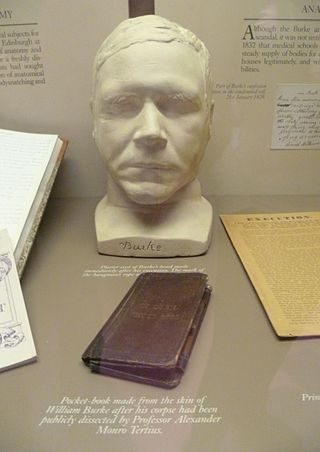- A reputedly anthropodermic copy of Hans Holbein's Dance of Death woodcuts; two copies have been confirmed as anthropodermic
- One of Bernhard Siegfried Albinus's pamphlets on anatomy kept at the Lane Medical Library
- The pocketbook reportedly bound in the skin of Crispus Attucks, considered most likely made of camel, horse, or goat hide
- Trial transcripts of the Red Barn Murder, reportedly bound in its perpetrator's skin

Anthropodermic bibliopegy —the binding of books in human skin—peaked in the 19th century. The practice was most popular amongst doctors, who had access to cadavers in their profession. It was nonetheless a rare phenomenon even at the peak of its popularity, and fraudulent claims were commonplace; by 2020, the Anthropodermic Book Project had confirmed the existence of 18 books bound in human skin, out of 31 tested cases. [1] [2] Though anthropodermic bibliopegy is commonly associated with Nazi Germany and the Holocaust, there is no evidence to suggest the Nazis bound books in the skin of Holocaust victims, nor for similar claims such as lampshades made from human skin. [3] [4] Rather, the practice fell out of favour early in the twentieth century. [5]
Contents
The ability to unequivocally identify book bindings as being of human skin dates only to the mid-2010s. For many years, identification tended to be visual, based predominantly on the structure of pores such as hair follicles in the skin. This could be combined with evidence as circumstantial as the bindings being of subjectively poor quality—taken as a sign the skin used was acquired through suspicious means. In the early twenty-first century, DNA testing emerged as a potential means of identification, but this was confounded by human handling; items frequently touched by human hands could produce false positives, as tests would pick up on their remnants. [5] DNA testing also proved non-viable owing to the degradation of DNA over time and the acceleration of such degradation by the tanning process used to turn skin into leather. [6] The development of peptide mass fingerprinting permitted conclusive testing and became the gold standard method. The first book confirmed as authentic through its use was in 2014; it was a copy of Des destinées de l'ame by the French philosopher Arsène Houssaye, held in the Houghton Library of Harvard University. [5] [6] [7] Ten years later, Harvard University removed the book's anthropodermic bindings. [8]
Not all putatively anthropodermic books have been subject to such testing. A library or archive may decline testing if their policies prohibit any technically destructive tests; peptide mass fingerprinting requires removing a minuscule portion of the book's bindings. Other collections may be unwilling to suffer possible negative publicity if a book is confirmed as bound in human skin. [9] Many others still remain to be tested, including those bound in the skin of executed criminals. While such books are generally treated as legitimate, due to their clear provenance compared to the mysterious or untraceable origins of most anthropodermic books, it is possible individual cases may be fraudulent. Such cases are further complicated by requests by descendants to return such books to the families, after which they may be buried or destroyed before they can be tested. [10]
Themes emerge in what purportedly anthropodermic books turn out to be legitimate or illegitimate. Books that call attention to the race of those whose skin was used to bind them, for instance, generally turn out to be frauds. Most legitimate anthropodermic books were owned or bound by physicians, and many of them are dedicated to the practice of medicine. In her book Dark Archives , the anthropodermic bibliopegy expert Megan Rosenbloom connects this to changing standards of medical ethics and the relatively recent emergence of the concept of consent in medicine. [2] [11] [12]
















